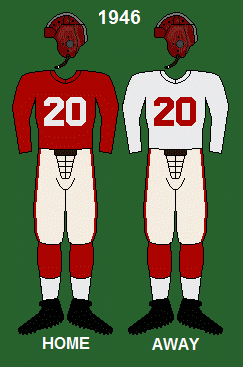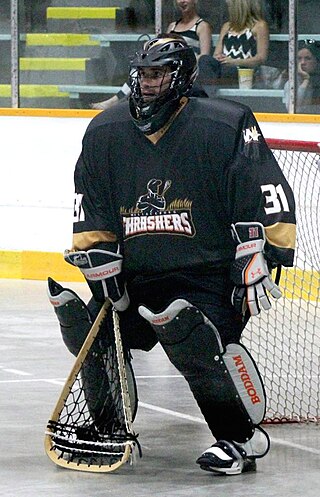
In many team sports that involve scoring goals, the goalkeeper is a designated player charged with directly preventing the opposing team from scoring by blocking or intercepting opposing shots on goal. Such positions exist in bandy, rink bandy, camogie, association football, Gaelic football, international rules football, floorball, handball, hurling, field hockey, ice hockey, roller hockey, lacrosse, ringette, rinkball, water polo, and shinty, as well as in other sports.
A jockstrap, also a jock (male), jill (female), strap, cup, groin guard, pelvic protector (female), supporter, or athletic supporter, is an undergarment for protecting the scrotum and penis or vulva during contact sports or other vigorous physical activity. This article deals chiefly with the genital protective sports gear designed for the male body, colloquially known as a "jock".

Cricket clothing and equipment is regulated by the laws of cricket. Cricket whites, sometimes called flannels, are loose-fitting clothes that are worn while playing cricket so as not to restrict the player's movement. Use of protective equipment, such as cricket helmets, gloves and pads, is also regulated.

Sports equipment, sporting equipment, also called sporting goods, are the tools, materials, apparel, and gear used to compete in a sport and varies depending on the sport. The equipment ranges from balls, nets, and protective gear like helmets. Sporting equipment can be used as protective gear or a tool used to help the athletes play the sport. Over time, sporting equipment has evolved because sports have started to require more protective gear to prevent injuries. Sporting equipment may be found in any department store or specific sporting equipment shops.
A football helmet is a type of protective headgear used mainly in gridiron football, although a structural variation has occasional use in Australian rules football. It consists of a hard plastic shell with thick padding on the inside, a face mask made of one or more plastic-coated metal bars, and a chinstrap. Each position has a different type of face mask to balance protection and visibility, and some players add polycarbonate visors to their helmets, which are used to protect their eyes from glare and impacts. Helmets are a requirement at all levels of organized football, except for non-tackle variations such as flag football. Although they are protective, players can and do still suffer head injuries such as concussions.

In ice hockey, the goaltender wears specialized goaltending equipment to protect themselves from the impact of the puck, and to assist in making saves. Ringette and rinkball goaltenders use the same equipment with some exceptions. This article deals chiefly with the sport of ice hockey.

Bunker gear is the personal protective equipment (PPE) used by firefighters. The term is derived from the fact that the trousers and boots are traditionally kept by the firefighters bunk at the fire station to be readily available for use.

Bike Athletic Company is an American sportswear company with headquarters in Atlanta, Georgia. They invented the jockstrap in 1874 for bicyclists in Boston. The firm sold over 350 million jockstraps.

Sportswear or activewear is clothing, including footwear, worn for sport or physical exercise. Sport-specific clothing is worn for most sports and physical exercise, for practical, comfort or safety reasons.

In ice hockey, players use specialized equipment both to facilitate the play of the game and for protection as this is a sport where injuries are common, therefore, all players are encouraged to protect their bodies from bruises and severe fractures.
The New York Giants of the National Football League have had numerous uniforms and logos since their founding in 1925.
Professionals and amateurs alike wear protective headgear (helmets) to reduce the chance of injury while playing American and Canadian football. The football helmet has changed over time and many different materials have become available. The rules of the game have changed as well.

The scrum cap is a form of headgear used by rugby players to protect the ears in the scrum, which can otherwise suffer injuries leading to the condition commonly known as cauliflower ears. Although originally designed for forwards they are now worn by players of all positions, even those who do not play in the scrum.

The logo and uniforms of the San Francisco 49ers have evolved since their inception in 1946.

The use of personal protective equipment (PPE) is inherent in the theory of universal precaution, which requires specialized clothing or equipment for the protection of individuals from hazard. The term is defined by the Occupational Safety and Health Administration (OSHA), which is responsible for PPE regulation, as the "equipment that protects employees from serious injury or illness resulting from contact with chemical, radiological, physical, electrical, mechanical, or other hazards." While there are common forms of PPEs such as gloves, eye shields, and respirators, the standard set in the OSHA definition indicates a wide coverage. This means that PPE involves a sizable range of equipment. There are several ways to classify them such as how gears could be physiological or environmental. The following list, however, sorts personal protective equipment according to function and body area.
Vaughn Hockey is a manufacturing company of ice hockey equipment founded in 1982 by company President Mike Vaughn.

Personal protective equipment serves an integral role in maintaining the safety of an athlete participating in a sport. The usage and development of protective gear in sports has evolved through time, and continues to advance over time. Many sports league or professional sports mandate the provision and usage of protective gear for athletes in the sport. Usage of protective gear is also mandated in college athletics and occasionally in amateur sports.

The goaltender or goalie is a playing position in indoor or box lacrosse. More heavily armoured than a field lacrosse goaltender, since the invent of indoor lacrosse in 1931, the box lacrosse goalie has evolved into a much different position than its field lacrosse cousin.

















